Planning a desert road trip? This 2-week Southwest USA itinerary covers the best places to visit across Utah, Arizona, and beyond—think national parks, scenic drives, and unforgettable landscapes.
If you’ve ever dreamed of towering red rock canyons, surreal desert landscapes, and national parks that look straight out of a sci-fi movie — this is the road trip for you. This 2-week Southwest USA itinerary takes you through some of the most jaw-dropping destinations in the American Southwest, including Death Valley, Zion, Bryce Canyon, Valley of Fire, and more.
From chasing sunrise views to hiking through sandstone arches, this itinerary is designed for travelers who want a mix of adventure, natural beauty, and unforgettable moments—without the burnout. Starting and ending in Las Vegas, you’ll explore iconic national parks, hidden gems, and landscapes that feel otherworldly.
Inside this guide: the full 14-day itinerary, best places to visit in the Southwest USA, driving tips, and all the info you need to plan the ultimate road trip. Let’s hit the road.
Read More // Don’t forget to check out all my USA blog post to make the most of your roadtrip!

QUICK OVERVIEW OF THE 2-WEEK SOUTHWEST USA ITINERARY
| Day | Destination | Highlight |
|---|---|---|
| 1-2 | Death Valley National Park | Mesquite Dunes, Zabriskie Point, Badwater Basin |
| 3 | Valley of Fire State Park | Fire Wave, Mouse’s Tank |
| 4-5 | Zion National Park | Angel’s Landing, Emerald Pools |
| 6 | Bryce Canyon National Park | Sunrise Point, Navajo Loop |
| 7-8 | Arches National Park (optional) | Delicate Arch, Scenic Drive |
| 9 | Horseshoe Bend & Page | Horseshoe Bend, Lake Powell (optional) |
| 10-11 | Grand Canyon National Park | South Rim, Desert View Drive |
| 12-13 | Sedona | Red Rock hikes, Chapel of the Holy Cross |
| 14 | Drive to Phoenix or loop back to Vegas | Scenic finish |
How to make the best of you 2-week Southwest USA Roadtrip
Days 1–2: Death Valley National Park
From Las Vegas to Death Valley: ~2 hours, 120 miles (193 km)
Start your Southwest USA road trip with a bang—Death Valley is one of the most surreal and dramatic landscapes in the country. Think salt flats that stretch for miles, golden canyons, and otherworldly colors that change with the light.
Where to Stay
Inside the park:
- The Inn at Death Valley – For a touch of luxury with spring-fed pools and desert views
- The Ranch at Death Valley – A more casual, family-friendly spot with restaurants and easy access to Furnace Creek
Camping inside the park:
- Furnace Creek Campground – The most popular and developed campground, near the visitor center (reservations available seasonally)
- Texas Springs Campground – First-come, first-served, no hookups, but stunning canyon views
- Sunset Campground – Large and flat, ideal for RVs or last-minute campers, right near Furnace Creek
- Mesquite Spring Campground – More remote and quieter, located near Ubehebe Crater
🛑 Staying inside the park makes sunrise and sunset photography way more accessible—you’ll thank yourself later for avoiding long pre-dawn drives.
What to See
Make the most of your 2 days by visiting a mix of iconic landmarks and hidden gems:
- Zabriskie Point (sunrise or golden hour = magic)
- Badwater Basin (lowest point in North America)
- Mesquite Flat Sand Dunes (fun to walk, great for photography)
- Artist’s Drive & Artist’s Palette (a 9-mile scenic loop full of wild colors)
- Dante’s View (epic panoramic lookout at 5,000+ ft elevation)
- Golden Canyon Trail (short and scenic hike through glowing walls)
Optional:
- Devil’s Golf Course (rugged salt spires)
- Ubehebe Crater (a bit further out, but worth it if you’re into geology or wide-open landscapes)
Pro Tips
Gas up before entering the park. Gas stations in the park are few and very pricey. Fill up in Pahrump or Beatty.
Bring water + snacks. Services are limited, and dehydration happens fast.
Weather warning: It gets dangerously hot in summer (over 45°C/113°F is normal), so visit in fall, winter, or early spring.
Read More // Want more ideas? Check out my detailed guide: Top Things to Do in Death Valley National Park

Day 3: Valley of Fire State Park
From Death Valley to Valley of Fire: ~2.5–3.5 hours, 150–180 miles (depending on your route)
Valley of Fire is often skipped on Southwest road trips—and honestly, that’s a mistake. With its glowing red rock formations, narrow slot canyons, and quick but rewarding hikes, this park feels like a mini-Mars. It’s the perfect one-day stop between Death Valley and Zion.
Short Hikes + Photo Ops
- Fire Wave Trail – A short 1.5-mile round-trip hike to the park’s most famous striped formation
- Mouse’s Tank Trail – Easy walk through a canyon with ancient petroglyphs
- White Domes Loop – A scenic 1.1-mile loop with dramatic rock walls and a slot canyon
- Rainbow Vista – Great for sunset and sweeping views (and very Instagrammable)
Picnic or Overnight?
Valley of Fire is a fantastic picnic stop with shaded tables, restrooms, and lots of quick trails right off the main road. If you want to linger longer, there are a couple of beautiful campsites right inside the park:
- Atlatl Rock Campground – First-come, first-served with shaded sites and flush toilets
- Arch Rock Campground – A bit more rustic but incredibly scenic
Read More // Want more ideas? Here’s the full breakdown of the best trails, views, and tips: The Best 8 Things to Do in Valley of Fire State Park

Days 4–5: Zion National Park
From Valley of Fire to Zion: ~2.5 hours, 130 miles (210 km)
Zion is one of those places that hits you right in the soul. Towering cliffs, lush valleys, and some of the most iconic hikes in the American Southwest—it’s a must on any 2-week road trip itinerary. Two days is a great amount of time to experience both the big-name hikes and the peaceful corners of the park.
Hiking Options for all Levels
Zion has something for everyone, whether you’re into intense climbs or easy riverside strolls:
Beginner to Easy:
- Pa’rus Trail – Paved, peaceful, and super photogenic
- Riverside Walk – Flat and shaded, leads to the entrance of The Narrows
- Lower Emerald Pools – Short and pretty, with waterfalls in spring
Moderate to Hard:
- Canyon Overlook Trail – Short but with huge payoff views
- The Narrows – A bucket-list hike in the river (rent gear in Springdale if it’s cold)
- Angels Landing – Famous, steep, and permit-required—but unforgettable
Shuttles & Logistics
- The Zion Canyon Shuttle runs from March to late November. Private cars aren’t allowed into the main canyon during that time.
- Park in Springdale and take the free Springdale Shuttle to the entrance.
- If you’re hiking Angels Landing, apply for a permit online in advance via the NPS lottery system.
- Bring plenty of water, sun protection, and snacks—Zion gets HOT and trails are exposed.
Where to Stay
- Zion White Bison Resort– A stunning glamping-style resort just minutes from the park entrance. Think luxury tents, private hot tubs, and red rock views.
- Other great options: Springdale hotels or nearby campgrounds if you’re after something more rustic.
Read More // First time visiting Zion? Don’t miss my full guide packed with beginner-friendly tips, trail breakdowns, and logistics help: Your Ultimate Zion National Park Guide for Beginners

Day 6: Bryce Canyon National Park
From Zion to Bryce: ~2 hours, 85 miles (137 km)
Don’t let the name fool you—Bryce isn’t a canyon, it’s an amphitheater of wild, fiery hoodoos that feel like a fantasy world. It’s compact, easy to navigate, and completely different from anything you’ve seen so far.
Best Viewpoints
You can cover a lot of Bryce in one full day, especially if you focus on the scenic drive and stop at key viewpoints:
- Sunrise Point – True to its name, it’s breathtaking early in the day
- Sunset Point – Equally stunning, especially in golden hour light
- Bryce Point – One of the highest and most panoramic spots in the park
- Inspiration Point – Layers on layers of hoodoos with insane depth
- Natural Bridge – A beautiful stop on the southern scenic drive
Want to hike? The Navajo Loop + Queen’s Garden Trail is a must if you only have one day to spend at this park. It takes you down among the hoodoos and back up with incredible views—moderate difficulty but totally worth it.
Where to Stay Near the Park
- Bryce Glamp & Camp – This cozy glamping spot just minutes from the park is ideal for unwinding after a day of exploring. Fire pits, warm showers, and stargazing-friendly tents make it a favorite for adventurers who still want a bit of comfort.
- Other options: Bryce Canyon City motels or Ruby’s Inn (classic but often booked out)
Read More // Need help planning your time at Bryce? Check out my full guide for trails, tips, and the best ways to experience the park: Bryce Canyon National Park Guide: Top Things to See and Do
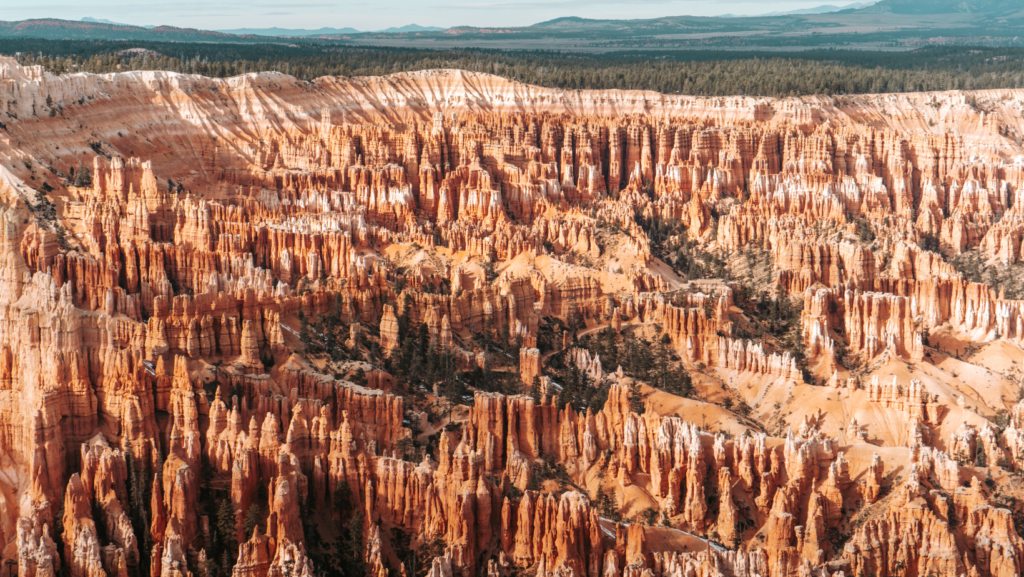
Days 7–8: Arches National Park (Optional)
From Bryce Canyon to Arches (via Scenic Byway 12 & I-70): ~4.5–5 hours, 250 miles (400 km)
If you’re up for the drive, Arches is absolutely worth it. With over 2,000 natural sandstone arches and dramatic desert backdrops, this park is like walking through a giant, open-air sculpture garden. It’s a bit of a detour, but if you’re skipping Page or Sedona, this is an incredible way to fill those days with epic views and must-see trails.
Why Arches is Worth the Trip
- You’ll get to hike to Delicate Arch, one of the most iconic symbols of the American Southwest
- The Windows Section is packed with arches you can walk right up to—easy, scenic, and great for photos
- Landscape Arch, one of the longest in the world, feels like it’s defying gravity
- You can drive the entire scenic loop in a day and still get a solid sense of the park
Short Hikes:
- Delicate Arch Trail – 3 miles round-trip, moderate with a steep final push
- Windows Loop & Turret Arch – Easy and super photogenic
- Sand Dune Arch – Short and shady, hidden between fins of red rock
Things to Know Before You Go
- Timed Entry Permits are required from April through October (between 7 am–4 pm). Reserve in advance on recreation.gov.
- Stay in Moab, the gateway town to Arches and nearby Canyonlands National Park if you want to extend your trip even further.
- Sunrise and sunset are magical here—Delicate Arch at golden hour is an unforgettable experience (just bring a headlamp for the hike back if staying for sunset)
If you’d rather cut down drive time, you can skip Arches and spend more time in Sedona, Page, or even add a slower day at Grand Canyon. But if you’re craving unique geology and red rock magic—Arches delivers.
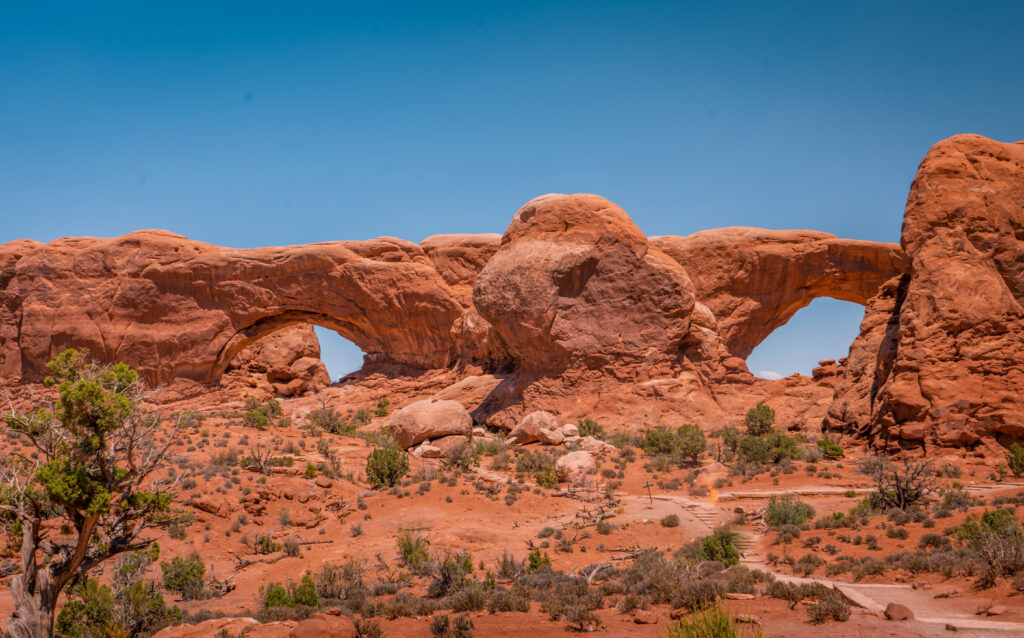
Day 9: Page + Horseshoe Bend
From Arches to Page: ~5 hours, 275 miles (443 km)
Or from Bryce Canyon to Page (if skipping Arches): ~2.5–3 hours, 150 miles (241 km)
Page is a perfect pivot point on your Southwest road trip. It’s home to one of the most photographed spots in the U.S.—Horseshoe Bend—as well as the famous slot canyons carved by flash floods and time. Whether you stop for a few hours or stay the night, there’s plenty to make this detour worth it.
Short Stop or Overnight
If you’re tight on time, you can hit Horseshoe Bend and drive on. But staying the night gives you a chance to explore more at a slower pace and catch golden hour or sunrise without rushing.
What to See
- Horseshoe Bend – Just a 10-minute drive from town and a 1.5-mile round-trip walk from the parking lot. Go early or late to avoid crowds and harsh light.
- Lake Powell / Glen Canyon Dam – Scenic views, kayaking, and tours if you have extra time
- Scenic Drive to Wahweap Overlook – Great sunset views over Lake Powell
Optional: Antelope Canyon
- Upper Antelope Canyon – The most famous, with those light beams you’ve seen all over Instagram
- Lower Antelope Canyon – Less crowded, with ladders and narrower paths (a bit more adventurous!)
- Both require guided tours and advance booking—you can’t explore them on your own. Book as early as possible, especially in spring and fall.
Where to Stay
- Plenty of motels and hotels in Page, or check for cozy Airbnbs with canyon or lake views
- For something memorable, look for stays with rooftop patios—perfect for stargazing
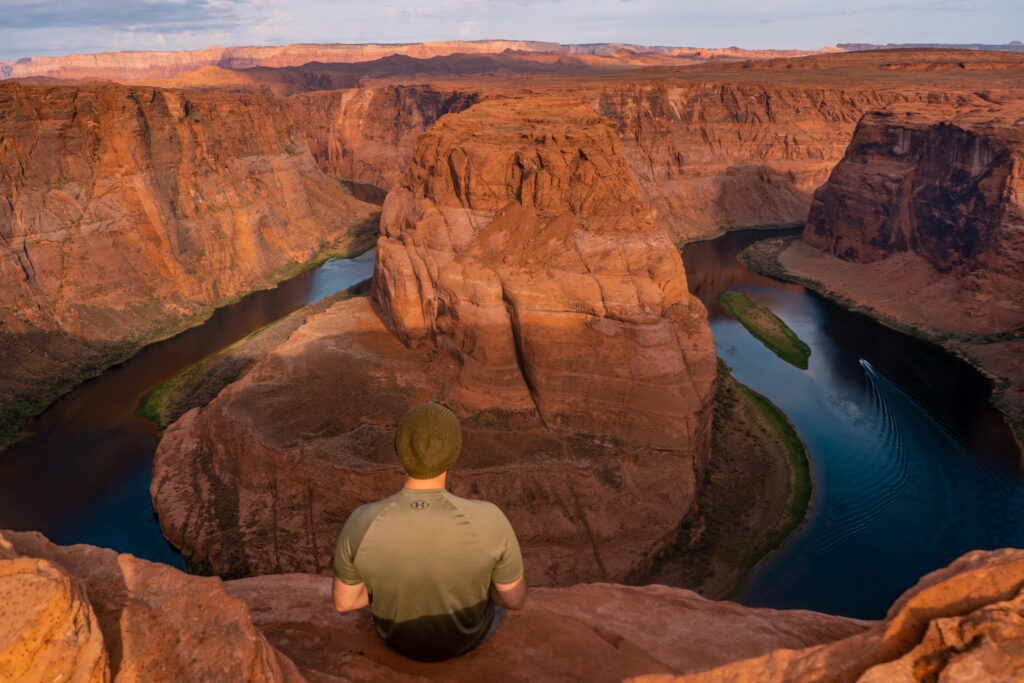
Days 10–11: Grand Canyon National Park (South Rim)
From Page to Grand Canyon South Rim: ~2.5 hours, 130 miles (209 km)
You’ve seen the photos, but nothing prepares you for standing on the edge of the Grand Canyon in real life. With two days, you’ll have time to explore the South Rim, which is open year-round and offers the most iconic views, hiking options, and visitor services.
Top Viewpoints
The Desert View Drive (Route 64) between the East Entrance and Grand Canyon Village is packed with scenic pullouts:
- Desert View Watchtower – Incredible views and a beautifully designed historic tower
- Lipan Point – A favorite for sunrise and layered canyon photos
- Grandview Point – Sweeping vistas with fewer crowds
- Mather Point – The classic first-timer view (busy, but worth it)
- Hopi Point – One of the best spots for sunset on the South Rim
Tip: These viewpoints are all drivable. Stop often, bring snacks, and take your time—each view hits differently.
Hiking Options
- Rim Trail – Mostly flat and paved in sections; do any portion between Mather Point and Hermit’s Rest
- South Kaibab Trail to Ooh Aah Point – ~1.8 miles round-trip, steep but short, with a massive payoff
- Bright Angel Trail (Partial) – Hike as far as you’re comfortable; 1.5 Mile Resthouse is a good turnaround point
Shuttles & Parking
- Free shuttle buses operate along the South Rim from March to November. Park once and use the shuttle to explore
- Try to enter through the East Entrance if coming from Page—it’s less crowded and puts you right on Desert View Drive
Where to Stay
Inside the park:
Yavapai Lodge or Bright Angel Lodge (book early!)
Outside the park:
Tusayan is just 15 minutes from the South Entrance with multiple hotels and restaurants
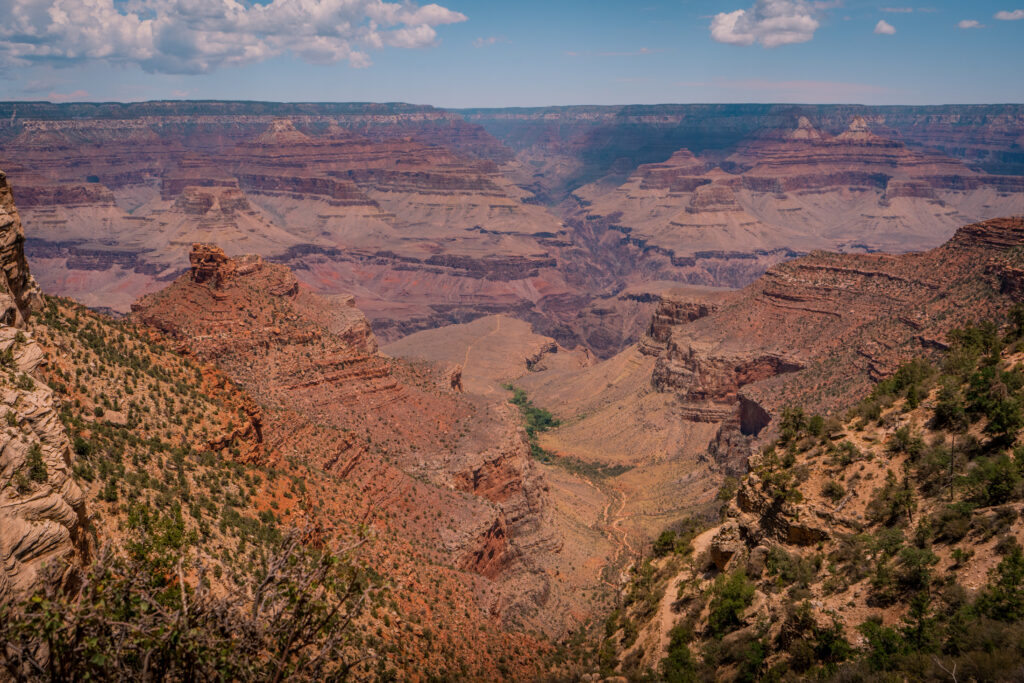
Days 12–13: Sedona
From Grand Canyon South Rim to Sedona: ~2.5 hours, 115 miles (185 km)
After days of desert heat, epic hikes, and early mornings, Sedona is the breath of fresh air you didn’t know you needed. Surrounded by towering red rock formations and buzzing with creative energy, it’s the perfect final stop for a mix of hiking, food, rest, and optional crystal-healing energy vortexes (if you’re into that sort of thing).
Best Hikes & Scenic Spots
Sedona has a lot of hiking options, but these are the go-tos for short visits:
- Cathedral Rock Trail – Short, steep, and stunning. Go at golden hour for jaw-dropping views
- Bell Rock + Courthouse Butte Loop – Easy to moderate, scenic the whole way
- Devil’s Bridge – Famous for the natural rock arch; popular, so go early or late
- Airport Mesa Viewpoint – Quick stop for sunset with panoramic views of the whole valley
Bonus: Sedona is known for its “energy vortexes.” Hikes like Boynton Canyon and Cathedral Rock are considered spiritual hotspots—perfect for journaling, meditating, or just soaking in the views.
Where to Eat, Chill & Explore
- The Coffee Pot Restaurant – Huge menu and local favorite for breakfast
- Creekside Coffee or Pump House Station – Great views with your latte
- Tlaquepaque Arts Village – For browsing local art, handmade jewelry, and souvenirs that don’t scream “tourist”
- Chapel of the Holy Cross – An iconic church built right into the red rock
Where to Stay
Sedona offers a range from cozy to upscale. Options include:
If you’re on a budget, check Village of Oak Creek just south of Sedona
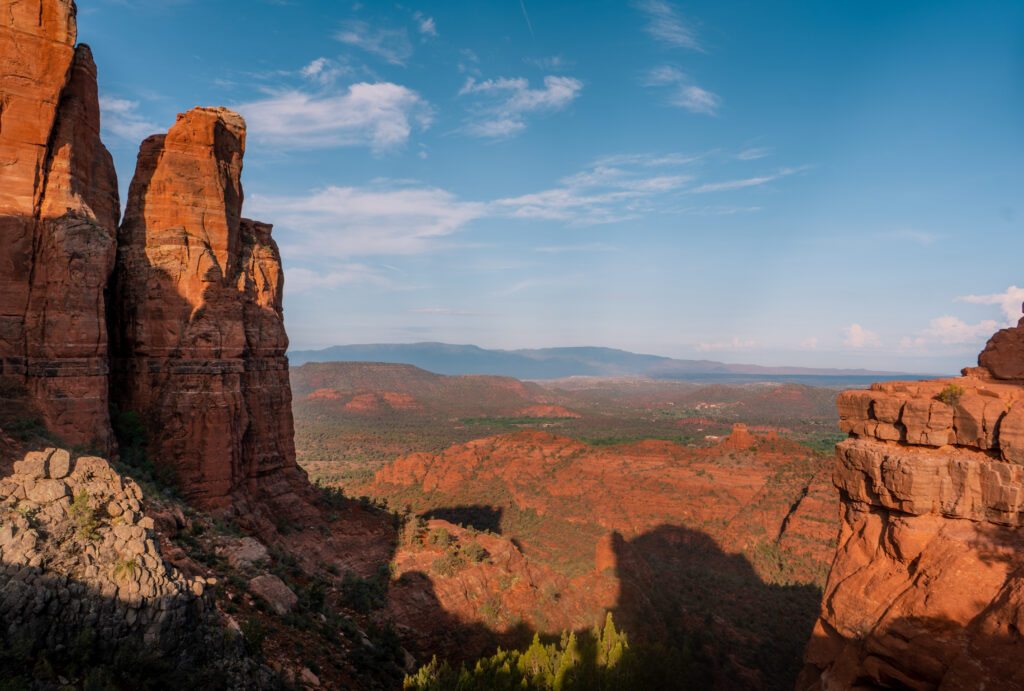
Day 14: Return to Las Vegas
From Sedona to Las Vegas: ~4.5 hours, 280 miles (450 km)
Time to cue the road trip playlist one last time. After a slow morning in Sedona—maybe one last coffee with red rock views or a quick trail—you’ll hit the road back to Las Vegas. The drive is long but scenic, passing desert plains, rocky outcrops, and that wide-open Southwest sky.
Travel Tips for a 2-week Southwest USA Road Trip
Planning your first Southwest USA road trip? Here are a few things to know before you hit the open road:
Best Time of Year
The best months for this itinerary are March to May and September to early November. Spring and fall bring comfortable temperatures, fewer crowds, and golden lighting for photography.
Summer (June–August) can be dangerously hot in places like Death Valley and even Zion. Winter is quiet and beautiful in spots like Bryce, but some areas may get snow or have limited access.
What to Pack
- Layers! Mornings can be chilly, afternoons hot—especially at higher elevations like Bryce
- A lightweight daypack for hikes
- Reusable water bottle or hydration pack (you’ll need way more water than you think)
- Sunscreen, lip balm with SPF, sunglasses, and a wide-brimmed hat
- Trail shoes or hiking boots with good grip
- A small first-aid kit and flashlight/headlamp (especially useful for sunrise/sunset hikes)
- National park maps or downloaded offline maps (cell service drops often in remote areas)
Entry Fees & Passes
Most parks on this route charge entrance fees between $10–$35 per vehicle.
If you’re visiting 3 or more national parks, it’s 100% worth getting the America the Beautiful Pass. It’s $80 USD and gives you access to all U.S. national parks and federal lands for a year.
Driving Tips
- Fill up on gas often, especially before entering Death Valley or driving long stretches between parks
- Some scenic drives have no service or roadside stops, so download maps in advance
- Watch for wildlife, especially early morning or dusk (deer, bighorn sheep, even coyotes)
- Check the weather and road conditions before heading into mountainous or high-elevation areas like Bryce
- Many parks use shuttle systems during peak seasons (Zion, Grand Canyon)—check schedules before arriving
FAQ: Planning Your 2-week Southwest USA Road Trip
Can you do a Southwest road trip in 2 weeks?
Yes, 2 weeks is a great amount of time for a Southwest road trip. You can cover several national parks, state parks, and scenic towns without feeling rushed—especially if you start and end in Las Vegas. This itinerary includes Death Valley, Valley of Fire, Zion, Bryce Canyon, Page, the Grand Canyon, and Sedona, with enough time to explore and enjoy each destination.
Is 2 weeks enough to see Zion, Bryce, and the Grand Canyon?
Absolutely. You can dedicate at least one full day to each of these parks—two days for Zion if you want to tackle a big hike like Angels Landing or The Narrows. Bryce Canyon is smaller and very manageable in a day, while the Grand Canyon South Rim is ideal for scenic drives, short hikes, and sunsets. This itinerary spaces them out nicely so you’re not driving back-to-back long distances.
Where should I stay during a Southwest USA road trip?
There’s a mix of options depending on your style and budget. Many national parks offer lodges and campgrounds inside or just outside the park gates, which are perfect for sunrise/sunset access. If you prefer more comfort or amenities, nearby towns like Springdale (Zion), Moab (Arches), Page, and Sedona offer everything from glamping to boutique hotels.
Bonus: I’ve listed my recommended places to stay in each section of this guide—including a few standout spots like Zion White Bison Resort and Bryce Camp & Glamp.
What kind of car do you need for a Southwest USA road trip?
You don’t need a 4×4 or anything fancy for this itinerary. A standard car or midsize SUV is totally fine for all the main roads, scenic drives, and national parks included here. Most of the routes are paved and well-maintained.
That said, if you’re planning to add remote stops (like off-road trails in Utah or Monument Valley), a high-clearance vehicle or SUV can be helpful. Just make sure your rental has unlimited mileage and that you’re covered for driving in rural areas. And always check the fuel level before heading into remote zones like Death Valley—gas stations can be hours apart.
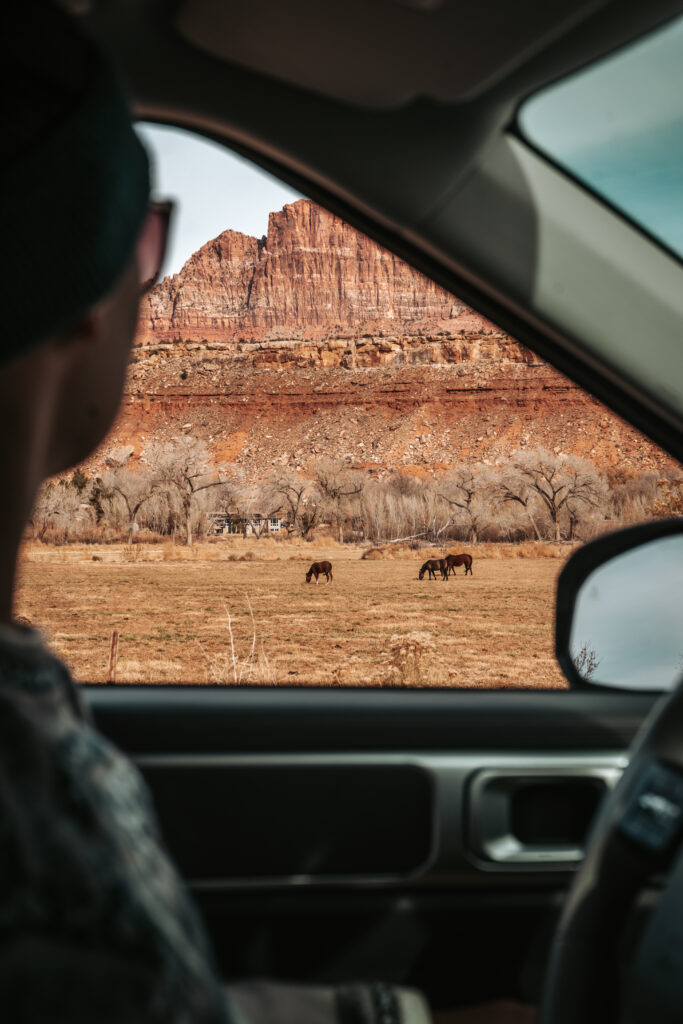
Don’t forget to check out all my USA blog post to make the most of your 2-week Southwest USA roadtrip
PIN THIS FOR LATER
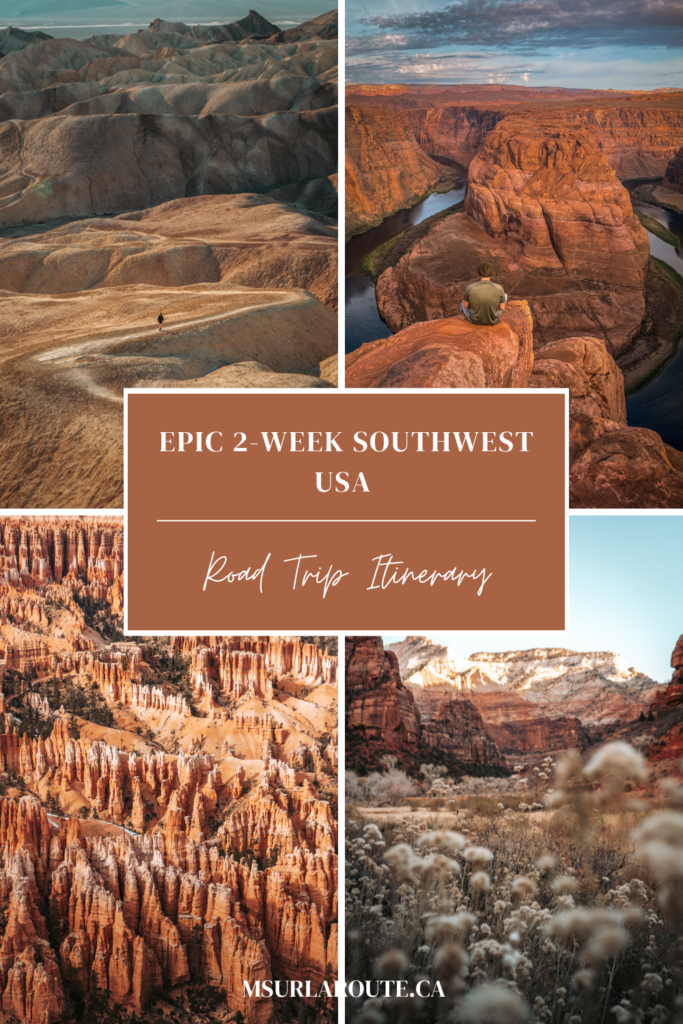
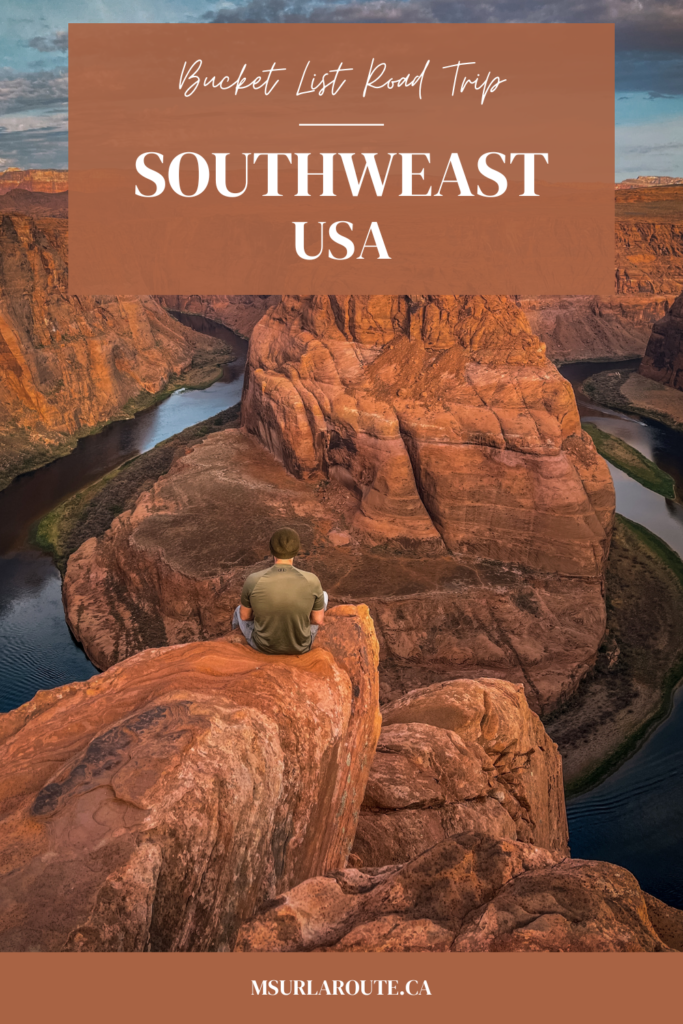
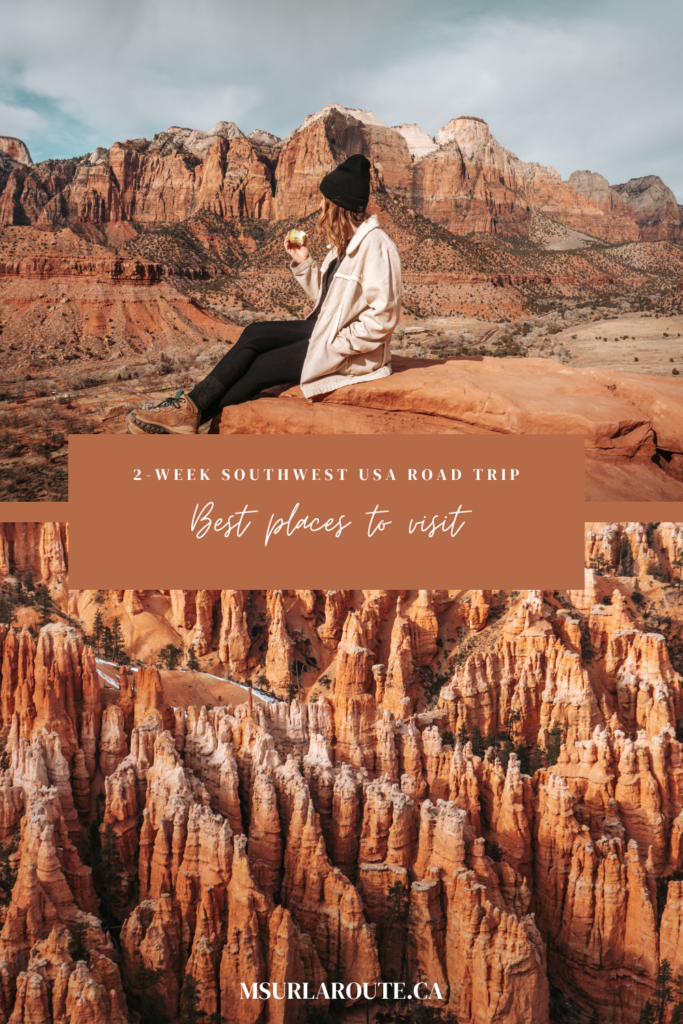
Follow me on Instagram!
Everyone visits Banff, but just an hour away, there’s also this. 👀
Grassi Lake in Kananaskis might just be one of the most underrated hikes in Alberta.
It’s short, it’s scenic, and the turquoise water? Totally unreal.
💦 Take the interpretive trail for waterfalls and forest views
⛰️ End at a lake so vibrant it looks photoshopped
So if you’re heading to the Rockies this summer, don’t sleep on Kananaskis.
Some of the best views are just off the radar.
💬 Been to Kananaskis or still on your list?
💾 Save this if you’re planning an Alberta trip!
🇫🇷 La version française est dans les commentaires! ⬇️
#GrassiLake #KananaskisCountry #AlbertaRoadTrip #HiddenGemsAlberta #ExploreKananaskis #HikingAlberta #BanffVsKananaskis #CanadianRockies #SummerInAlberta

Did you know you can tour Prince Edward County’s wineries in a vintage hippy van? 🚐🍷
Yep, it’s just as fun as it sounds.
Westy Wine Tours lets you customize your dream wine day in the cutest retro vans (yellow, blue, or pink, your pick!). I stopped at:
🍷 Traynor Vineyard for their famous wine slushy
🌸 Rosehall Run for a glass of their Pixie Rosé
🍹 Old Salt Cocktails for craft drinks, hot dogs, and a round of mini games
It’s the ultimate summer vibe : good wine, good company, and very aesthetic transportation.
💬 Which van are you choosing: yellow, blue, or pink?
💾 Save this for your next PEC weekend!
🇫🇷 La version française de ce texte se trouve dans les commentaires.
*invited*
#PrinceEdwardCounty #PECwine #WestyWineTour #OntarioWineries #WineTourOntario #RetroVanTour #ExploreOntario #GirlsWeekendVibes #PECgetaway #OntarioAdventures #WeekendInTheCounty #summerinpec

Planning a summer weekend in Bruce Peninsula? 🏕️🌊
Here’s your guide to make it iconic: turquoise waters, epic hikes, quiet beaches, and the cutest glamping stay.
Start in Tobermory with coffee and a boat tour, spend the night in a luxe tent at the Grotto Getaway, then hike to Lion’s Head Lookout (one of my fave views in all of Ontario). Finish with a beach day on the quieter side of the peninsula. — And a reminder that yes, Ontario can absolutely deliver on those summer getaway dreams. 💫
💾 Save this itinerary for your next long weekend in Bruce County!
👇 Been to the Bruce? What’s your must-do?
👇 Never been? What’s holding you back?
🇫🇷 La version française de ce texte se trouve dans les commentaires.
#BrucePeninsula #TobermoryOntario #LionsHead #OntarioHikes #GrottoGetaway #ExploreOntario #WeekendGetawayOntario

This might just be the most beautiful stay in Ontario, and trust me, I’ve stayed in a lot of beautiful places. ✨
Aux Box in Muskoka is a dreamy off-grid cabin tucked in the forest… and it just got even better.
They’ve added a brand new Nordic spa setup: a cedar sauna, hot tub, and cold plunge, all surrounded by trees and birdsong.
It’s peaceful, cozy, and ridiculously aesthetic.
Perfect for a solo reset, a couples retreat, or a weekend escape where your only plan is to do nothing (in style). 🛁🔥❄️
💾 Save this for your next Ontario getaway idea. This one’s so worth the drive.
👇 Would you try the cold plunge or just stick to the hot tub? Be honest.
🇫🇷 La version française de ce texte se trouve dans les commentaires
*collab*
#MuskokaGetaway #OntarioStaycation #UniqueStaysOntario #OntarioCabins #TinyCabinLife #glampingontario

Everyone knows Algonquin, but did you know that just 30 minutes away, there’s a quieter park that’s still totally worth a visit? 🌲✨
Arrowhead Provincial Park might not have the same dramatic views as Algonquin, but it makes up for it with peaceful trails, cozy campsites, and way fewer crowds.
In the summer, you can see the Big Bend lookout, paddle on calm lakes, or unwind at your campsite surrounded by trees. In the fall, the colors are next-level. And in the winter? That forest ice skating trail is straight out of a movie. ❄️⛸️
💾 Save this mini guide for your next Ontario park day. Arrowhead deserves a spot on your list.
🇫🇷 La version française de ce texte se trouve dans les commentaires
👇 Been here already? Tell me your favorite Ontario park that flies under the radar!
#ArrowheadProvincialPark #OntarioParks #ExploreOntario #HiddenGemsOntario #SummerInOntario #OntarioHiking #DiscoverON

